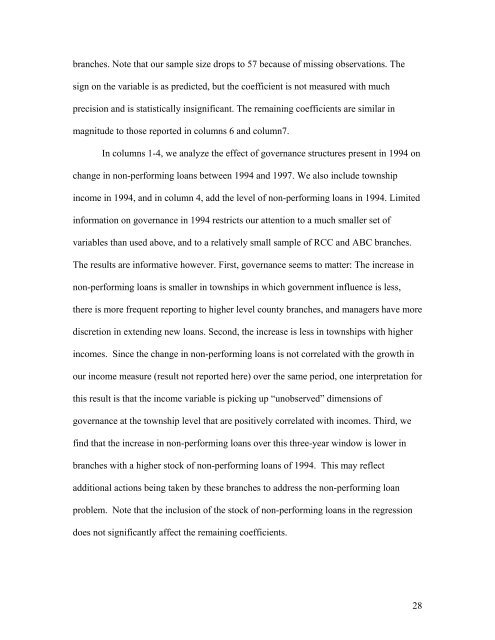Are China's Financial Reforms Leaving the Poor Behind - Harvard ...
Are China's Financial Reforms Leaving the Poor Behind - Harvard ...
Are China's Financial Reforms Leaving the Poor Behind - Harvard ...
Create successful ePaper yourself
Turn your PDF publications into a flip-book with our unique Google optimized e-Paper software.
anches. Note that our sample size drops to 57 because of missing observations. Thesign on <strong>the</strong> variable is as predicted, but <strong>the</strong> coefficient is not measured with muchprecision and is statistically insignificant. The remaining coefficients are similar inmagnitude to those reported in columns 6 and column7.In columns 1-4, we analyze <strong>the</strong> effect of governance structures present in 1994 onchange in non-performing loans between 1994 and 1997. We also include townshipincome in 1994, and in column 4, add <strong>the</strong> level of non-performing loans in 1994. Limitedinformation on governance in 1994 restricts our attention to a much smaller set ofvariables than used above, and to a relatively small sample of RCC and ABC branches.The results are informative however. First, governance seems to matter: The increase innon-performing loans is smaller in townships in which government influence is less,<strong>the</strong>re is more frequent reporting to higher level county branches, and managers have morediscretion in extending new loans. Second, <strong>the</strong> increase is less in townships with higherincomes. Since <strong>the</strong> change in non-performing loans is not correlated with <strong>the</strong> growth inour income measure (result not reported here) over <strong>the</strong> same period, one interpretation forthis result is that <strong>the</strong> income variable is picking up “unobserved” dimensions ofgovernance at <strong>the</strong> township level that are positively correlated with incomes. Third, wefind that <strong>the</strong> increase in non-performing loans over this three-year window is lower inbranches with a higher stock of non-performing loans of 1994. This may reflectadditional actions being taken by <strong>the</strong>se branches to address <strong>the</strong> non-performing loanproblem. Note that <strong>the</strong> inclusion of <strong>the</strong> stock of non-performing loans in <strong>the</strong> regressiondoes not significantly affect <strong>the</strong> remaining coefficients.28















